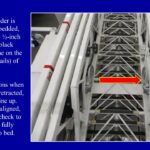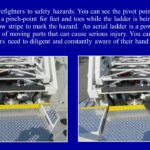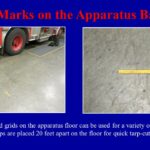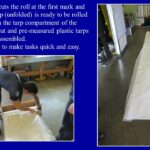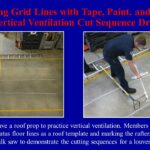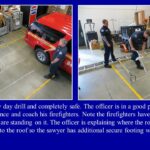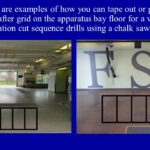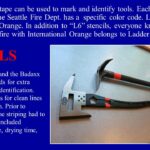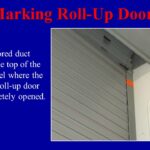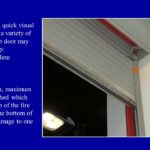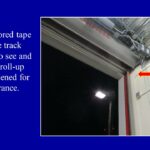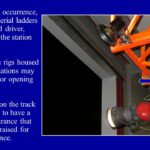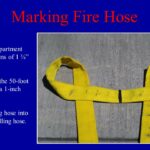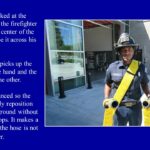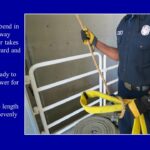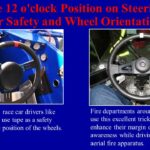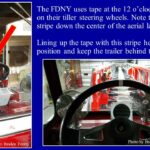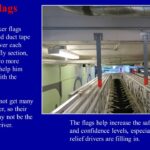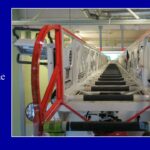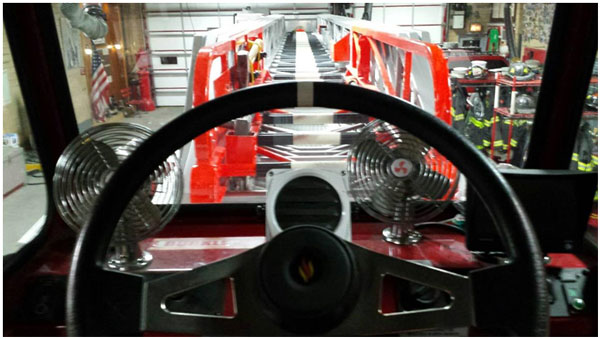
By Raul Angulo
One of the most important tools in the fire service isn’t something you’re going to be issued, nor is it something you can buy at Home Depot. You can buy it at a drug store, but most likely it’s in your EMS supply locker: one-inch first aid tape. Every firefighter should carry a roll of tape in their bunking coat. It’s an issue of professional preparedness. The obvious use of first-aid tape is to indicate a primary search is taking place (/), and when it’s finished (X). A firefighter can use tape to his benefit in a number of scenarios. Let’s look at a few.
Tiller Wheel Tape
Here’s a unique one, but first, let me ask you a question: What do you think of when you hear the term “professional driver”? Most guys would say a race car driver. Me too! I found it interesting that NASCAR drivers use a one-inch piece of tape to mark their steering wheels at the 12 o’clock position to visually indicate where the wheels are pointing. The tape can help a driver recover from a spinout in speeds of over 100 mph. Also, the temperature inside the driver compartment of a race car can reach up to 110°F and drivers can get fatigued, so the tape doubles as a safety tool to help the driver orient the position of the car and enhance his margin of safety during a long race. I don’t know who started it first, but many fire departments also use tape–a one-inch piece of white tape at the 12 o’clock (or six o’clock) position on the rear steering wheel of a tillered aerial fire apparatus. Fire departments like the Fire Department of New York, San Francisco, cities in the Bay Area, Los Angeles County, and Baltimore County all train and run with one-inch tape on the tiller steering wheel.
The Seattle (WA) Fire Department is now an all-tillered aerial fleet. Ladder 7 is the only remaining straight-frame, rear mounted aerial ladder. Ladder 6 received a new Pierce tillered 100-foot aerial ladder in 2013 and my guys were very excited to finally drive the iconic tiller fire truck.
Driving a tiller truck or tractor-driven aerial (TDA) in downtown Seattle is more forgiving than driving on top of Queen Anne Hill. Streets are wide and they’re lit up at night by street lights, lit buildings, and neon advertising marquees. Not so on the hill. These residential tree-lined streets in our district are dark and narrow, especially at night. With cars parked on both sides of the street, there’s no room for error. Plus, the inside of the tiller cage is dark, making it more challenging to maneuver at night. My tillermen quickly figured out that a strip of one-inch white tape at the 12 o’clock position on the steering wheel helps them orient the position of the trailer–especially at night.
Despite the departments mentioned above, I know there are “tiller specialists” and driving instructors who frown on using the tape as a teaching aid in favor of developing muscle memory. Seriously? My question is what happens when your muscles are sore or stiff? I don’t know of a single fire department in the country that expects their drivers to use muscle memory when backing an apparatus into a fire station. Every apparatus bay that I’ve seen has lines painted on the floor to assist the driver line up the rig.
We don’t expect an aerial operator to rely on muscle memory to extend the ladder out 75-feet at a 60-degree angle, do we? Every aerial ladder that I’ve seen, including mine, has the ladder beams (rails) marked off every five feet with red stripes which were applied at the factory. There is also a bubble gauge or swing needle on aerial apparatus to indicate the ladder angle.
I’ve heard of driving instructors saying using tape on the tiller steering wheel is “unprofessional” or “real tillermen don’t use tape.” These concepts are ridiculous, arrogant, and quite frankly should be abandoned. Here’s the end game: driving the fire apparatus to and from an emergency without incident—safely–so everyone can go home. I’m for giving my firefighters every tool they need to perform any job safely and with confidence. If your guys want to use tape to make driving these behemoth rigs safer and easier, let them use the tape!
Dash Tape
Here’s another example. I know a driver who uses a ¼-inch inch piece of white tape on the dash to help him line up his aerial apparatus on the centerline of a lane. He also uses another ¼-inch strip of white tape on the dash to mark the fog line so he knows where the right side of the apparatus is in relation to the shoulder of the road. Again, these new rigs are gigantic and expensive. When you’re driving a $1.2 million fire apparatus, any training aid or tool you can use to reduce your chances of having an accident is okay in my book. It’s a shame to have high-tech first line rigs in the shop for body repairs that were preventable.
Aerial Ladder Tape, Stripes, and Flags
Our new Pierce aerial comes with two cameras and monitors for the tillerman; one above each rear wheel. The rig is so big, without the cameras the tillerman would not be able to see the left side wheel line on the apparatus floor when returning to quarters. Even with cameras, it’s a tricky maneuver because the tillerman is coming out of a wide swing and needs to quickly line up the trailer with the tractor beacon light in order to enter the narrow apparatus bay. Two of my tillermen came up with a great idea. They made two marker flags out of weighted duct tape and suspended them from the mid-bay overhead. Each flag drops down right over the left and right beams (rails) of the aerial fly section. It’s much easier to position the trailer behind the tractor by lining up the ladder beams to the flags than simply trying to center the aerial rungs to the light beacon on top of the cab. These marker flags increase the safety margin and confidence level for the tillerman because there two more reference points.
Another operational aid that many aerial apparatus drivers use is ½-inch black electrical tape to mark each fly section of the aerial ladder, including the bed section, with a stripe to ensure that the aerial ladder is fully retracted. When the stripes on each fly section line up, it’s a quick visual assurance that the aerial ladder is fully retracted and can be safely bedded.
Aerial ladders have many powerful moving parts that could cause serious injury. On our aerial ladder turntable and step to the bottom rung, we discovered that the pivot point where the ladder raises and lowers creates a dangerous pinch hazard for firefighters. The step is a natural place to rest one’s foot while waiting for the ladder to raise or lower, but if you’re not careful, it could pinch your toes. Our solution was to notify every member of the hazard in writing and paint a two-inch yellow line across the step, clearly identifying the hazard area. This is another procedure you wouldn’t want to leave to muscle memory. One slip of attentiveness and you could be missing some digits of the lower extremities.
Ground Extension Ladder Beam Tape
Another good use for tape is for marking the beams of ground extension ladders at the halfway point. Place a one-inch strip of tape halfway along the beam of all the extension ladders carried on the ladder truck. For one-man ladder shoulder carries or beam carries, the halfway marker is also the approximate balancing point. As the firefighter is pulling the ladder out from the rear ladder rack, he can hook the rung closest to the tape and know the ladder is balanced. For two-man cradle carries, the firefighters place their hands on either side of the tape for a balanced carry. For a two-man shoulder carry, the tape helps the second firefighter judge the second to the last rung.
Floor Stripes
Ladder 6 still carries large heavy-duty canvas tarps for salvage covers and often they’re the right tool for the job. But they require maintenance, cleaning, and, if wet, they have to hang in the hose tower to completely dry. Large Visqueen plastic tarps have become more popular and have a variety of uses. We use them to cover broken windows and ventilation holes in roofs. They’re excellent for water jobs and for covering furniture when there isn’t a fire threat. Best of all, they’re disposable and you can leave the tarps at the scene. The Visqueen comes in rolls of 500 or 1,000 feet. They open up to 20 feet in width. We cut them in 20-foot lengths so when unfolded, we end up with 20 foot x 20 foot tarps.
To make cutting easier, my guys placed two one-inch stripes 20 feet apart on the apparatus floor. When it’s time to replenish the tarp inventory, they simply hold one edge of the roll on the first stripe and roll it out to the second stripe, then cut.
Floor striping in the apparatus bay can also be used to draw the layout of roof rafters. Using a chalk saw, firefighters can practice the cut sequences for vertical ventilation. This is a great rainy day drill.
Tool Tape
Duct tape is fashionably in style. The traditional gray duct tape is still the most popular, but rolls now come in a variety of colors and designs. In Seattle, we have 11 ladder companies, each with their own assigned color code to mark tools and equipment for easy identification. Ladder 6’s color is International Orange. Duct tape is available in International Orange, so I decided to pick up a few rolls to mark the tools and equipment. We used to paint the orange stripes on tools and equipment, but that required prep work and touch-ups. Wrapping a tool with two-inch duct tape makes for an easy identifiable marking with clean lines and no drying time.
Roll-up Apparatus Door Stripes
Many fire stations, including ours, have roll-up bay doors and most of them are motor-driven. For a variety of reasons (mechanical problems, human error, or intentional), the doors don’t always roll all the way up. This doesn’t happen very often, but all it takes is one time. If the clearance from the top of the fire apparatus to the bottom of the raised door is reduced–and if the driver or firefighters are not attentive–the apparatus will make contact with the door causing damage to one or both.
Two events that are more common are excited or impatient drivers who don’t wait until the roll-up door is fully raised before responding out of the station, or a remote control unit that is accidentally bumped before the apparatus has cleared the station, causing the door to close on top of the rig.
One way to help prevent these accidents is to place a two-inch strip of bright duct tape (in this case, International Orange) on each side of the roll-up door at the base. Place another strip of bright colored duct tape at the top of the columns of the bay door opening. As the door rolls up, the base marker stripes will approach the column markers. When the door is fully opened, the two stripes will line up. This is a quick visual indicator that the door is fully raised and you have maximum clearance. If the lines are off, or the door stripe is significantly lower than the column stripe, it is also a quick visual indicator that the door is not fully opened and clearance is diminished.
Fire Hose Stripes
Finally, we use a one-inch black stripe to mark the middle of every section on 1 ¾-inch and 2 ½-inch fire hose. In Seattle, our fire hoses are 100-foot sections, so we mark it at the 50-foot mark. This is helpful for quickly identifying the middle of the hose to hang in the hose tower, for loading hose on the apparatus, and for effectively repositioning hoselines on the fireground.
*
Muscle memory has certain applications, but I’ve seen firefighters and officers (including chiefs) who can’t even remember to put their helmet on at a fire scene! So much for memory. Relying simply on memory is risky. We’re human. We make mistakes, we forget, we misjudge, and miscalculate. The fire service of today exists in a very litigious society. Cell phones and cameras record our every move and the public always wants someone to blame. We need to recognize how to limit our exposure to liability and prevent predicable accidents, especially with the movement of fire apparatus. Any teaching aid–whether it’s tape, markers, flags, or cameras–that helps us navigate through busy, narrow streets and prevents accidents from happening should be encouraged and used. Those who scoff and resist just don’t get it.
Hydraulic moving parts of an apparatus and rescue tools are extremely powerful and dangerous if we’re not careful. Tape or stripes that indicate correct positioning can be helpful in keeping operations safe.
Tools and equipment are expensive. Losing and the replacement of lost tools is a waste of money that could be spent acquiring new tools, like new thermal imaging cameras that help us do our jobs safer and save lives.
Using tape or marker stripes is not “cheating” or unprofessional. A real professional works smarter, safer, and makes an already tough job easier. Who would resist that? Only an unprofessional.
- Q & A: Raul Angulo on Drills You Won’t Find in the Books
- Drills You Won’t Find in the Books: Roll-Up Doors–In or Out?
- Drills You Won’t Find in the Books: Elevator and Stairwell identification Drill
 RAUL A. ANGULO is a 37-year veteran and captain of Ladder Co. 6 with the Seattle (WA) Fire Department. He is an international author and instructor on various fire service subjects including strategy and tactics with firefighter accountability, crew development, and company officer leadership. He writes the monthly column “Tool Tech” for Fire Apparatus and Emergency Equipment magazine.
RAUL A. ANGULO is a 37-year veteran and captain of Ladder Co. 6 with the Seattle (WA) Fire Department. He is an international author and instructor on various fire service subjects including strategy and tactics with firefighter accountability, crew development, and company officer leadership. He writes the monthly column “Tool Tech” for Fire Apparatus and Emergency Equipment magazine.


